Physical Address
304 North Cardinal St.
Dorchester Center, MA 02124
Most of the injuries that occur in the ankle and foot of the pediatric athlete are not unique to athletic participation but occur normally during childhood. However, some injuries occur with greater frequency in the athlete. The conditions covered in this chapter occur in childhood and may present in the athlete, raising the question of whether the athlete should be allowed to participate in sports activities. As a general rule, in all of these conditions, if a patient has an injury or an operation, we allow return to play (RTP) when he or she has full range of motion (ROM) and the strength and ability to perform all the activities involved in the sport without pain.
Tarsal coalition is a bony or fibrous or cartilaginous connection of two or more of the tarsal bones. The cause is unknown, but it has been established that the condition results from failure of differentiation and segmentation of the primitive mesenchyme. The overall clinical incidence is 1% to 3%. The incidence of osseous, cartilaginous, or fibrous coalition was 13% in a cadaver study, suggesting that many coalitions are asymptomatic. The most common coalitions are the calcaneonavicular and talocalcaneal types, which are bilateral in approximately 60% and 50% of cases, respectively. More than one type of coalition can exist in one foot. A review of 60 cases of tarsal coalition found that 6 of 30 patients had multiple coalitions in the same foot. The exact mode of inheritance is unknown, but it is postulated to be autosomal dominant with variable penetrance.
Most patients seek medical care during early adolescence, at a time when the coalition is ossifying. The pain is vague in nature and insidious in onset. The patient may have a history of frequent ankle sprains or precipitating trauma. Sports participation or running over uneven ground may accentuate the pain. The pain is thought to be due to microfractures in the coalition. Physical findings include pain on palpation over the subtalar joint, limited subtalar motion, and at times pes planus and ankle valgus. The peroneal muscles may be tight and resist inversion, but true muscle spasm occurs rarely ( Fig. 138.1 ). Any condition that injures the subtalar joint can produce similar symptoms.
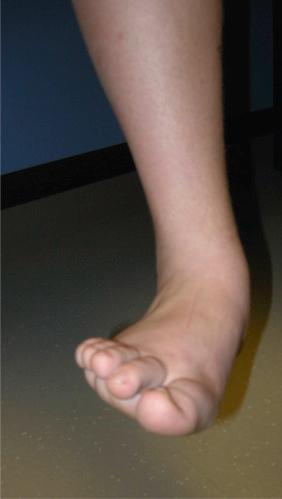
The clinical diagnosis can be confirmed by radiographic imaging. Plain radiographs, especially the 45-degree oblique view ( Fig. 138.2 ), usually demonstrate the calcaneonavicular coalition and other less common coalitions, such as the calcaneocuboid. The talocalcaneal coalition (TCC) is difficult to visualize on plain radiographs, but secondary changes, which may suggest the need for other studies ( Fig. 138.3 ), include beaking and shortening of the talar neck, a middle subtalar facet that cannot be seen, elongation of the lateral process of the calcaneus, a ball-and-socket ankle joint, and the C-sign (see Fig. 138.3 ).
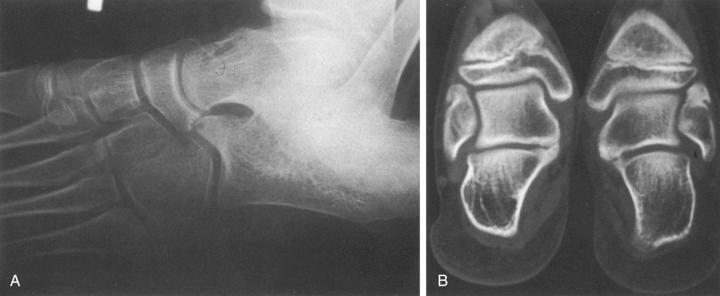
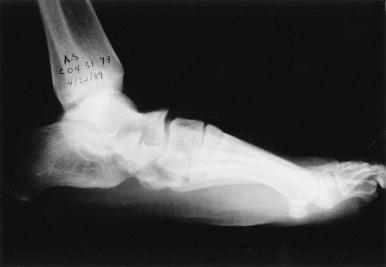
Crim and Kjeldsberg studied two groups of 30 patients with tarsal coalition and 17 control subjects. A second group of patients with 150 weight-bearing radiographs for nontraumatic foot pain were reviewed for cases of undetected tarsal coalition. These investigators identified several previously undescribed plain radiographic signs for coalitions. For calcaneonavicular coalitions, these signs were altered navicular structure and visualization of the bar on the anteroposterior (AP) radiograph. For TCCs, the changes were a dysmorphic sustentaculum tali, nonvisualization of the middle subtalar facet, and shortening of the talar neck. When these criteria were used in the 150 prospective cases, three previously undetected coalitions were diagnosed and then confirmed by computed tomography (CT), with no false-positive results.
If a calcaneonavicular coalition is present on plain radiographs, a CT scan should be obtained to ensure that no other coalitions exist, which is necessary for surgical planning (see Fig. 138.2 ). A CT or magnetic resonance imaging (MRI) scan can also be performed if a coalition is suspected clinically but none is identified on plain films. CT is easily performed, delineates bony anatomy quite well, and can be formatted into a three-dimensional (3D) image that is useful when planning surgery. MRI has the advantage of demonstrating fibrous or cartilaginous lesions, as well as bony lesions. MRI avoids radiation but at greater cost than CT.
El Rassi and colleagues reviewed 19 patients with symptoms and signs consistent with tarsal coalition and normal imaging studies. These investigators used technetium-99m scintigraphy and found slightly increased uptake in the middle facet. They obtained good or fair results in all patients after resection of hypervascular capsule and synovium, which had produced arthrofibrosis.
The initial treatment of these conditions should include conservative measures aimed at relieving the pain. These measures are empirical and include casting and the use of various shoe inserts and orthotics. The main indication for surgical resection is persistent pain. For calcaneonavicular coalition, resection of the bar with interposition of the extensor digitorum brevis is usually associated with good results. Studies by Cowell and Jayakumar and Cowell indicated that 23 of 26 feet treated in this manner became symptom free.
TCC historically was more difficult to recognize, and its surgical management is less certain. Before the advent of CT, the diagnosis was often confirmed at the time of surgery. Jayakumar and Cowell reported that up to one-third of their patients responded to conservative treatment, and they believed that few indications for resection exist. This conclusion was based on evidence from family studies indicating that many adults with tarsal coalition were asymptomatic. The surgical alternatives include resection of the bar with interposition of fat or tendon, calcaneal osteotomy, and triple arthrodesis.
Scranton reviewed 14 patients with 23 symptomatic TCCs. Five feet (in three patients) were treated successfully with casts. Four feet were treated with triple arthrodesis. Eight patients with 13 coalitions that had been resected had a good result. The review was performed at a mean of 3.9 years after surgery. In Scranton's series, approximately half of the joint surface was removed in some patients. In the series reported by Swiontkowski and associates, 10 patients were treated for TCC—four by resection of the bar, and the remainder with some type of arthrodesis. This article stressed that the talar beak is not a true degenerative sign and therefore is not a contraindication to resection of the bar. Olney and Asher evaluated nine patients with persistent pain from 10 middle-facet TCCs who were treated with resection of the bar and an autogenous fat graft. At an average follow-up of 42 months, the results were rated excellent in five patients, good in three patients, fair in one patient, and poor in one patient. In one patient who underwent a repeat operation, the fat graft had been replaced by fibrous tissue.
Luhmann and Schoenecker used CT to evaluate TCC in 25 feet. They quantified heel valgus and the size of the coalition relative to the posterior facet. The ratio of mean TCC cross-sectional area to the posterior facet was 53.4%. Mean hindfoot valgus was 17.8 degrees. Statistical analysis determined a significant association between TCC greater than 50% the size of the posterior facet and poor outcome ( P = .014). Heel valgus greater than 21 degrees was also associated with poor outcome ( P = .014). However, good results were obtained in some patients with a TCC greater than 50% and in patients with heel valgus greater than 21 degrees.
Comfort and Johnson reviewed resection of 20 TCCs at an average of 29 months of follow-up. They found good or excellent results with resections involving less than one-third of the total joint surface. They did not find increasing age to be a contradiction to the procedure. Gantsoudes et al. have provided an excellent review of outcomes with use of interpositional fat. In 49 feet with a minimum follow-up of 12 months (and an average follow-up of 42.6 months), an average score of 90/100 (excellent) was achieved with use of the American Orthopedic Foot and Ankle Society Hindfoot scale. Eleven patients (34%) required subsequent surgery to correct foot alignment. Good to excellent results were achieved in 85% of patients.
The management of these coalitions is still controversial and awaits the results of larger series with longer follow-up. Patients with persistent symptoms who do not have degenerative findings have the option of continued conservative care, resection of the coalition, or arthrodesis. Talar beaking is not necessarily a degenerative sign. Factors to consider are the size of the coalition and the age of the patient. Severe malalignment of the foot is a contraindication to resection alone. Although a triple arthrodesis was considered a treatment for failed resections and continued pain, other options should be considered to balance or realign the foot. A sliding osteotomy or medial closing wedge as described by Cain and Hyman can be used to realign the foot. Mosca has written that correction of the valgus deformity and any equinus contracture appears to be as important as resection of the coalition. He recommends calcaneal lengthening osteotomy with gastrocnemius or Achilles tendon lengthening as effective in these cases for correcting deformity and relieving pain in these rigid flat feet.
The cause of adolescent bunion is unknown. Fifty percent to 60% of patients have a positive family history. Patients with this condition have an increased intermetatarsal angle (the angle between the first and second metatarsals, normally 10 degrees) and an increased first metatarsal–phalangeal angle (normally 20 degrees). Many patients also have a relaxed flatfoot and a long first metatarsal ray. None of these conditions is known to be the cause of adolescent bunion. Footwear has been implicated, but because bunions occur in cultures in which shoes are not worn, this theory seems unlikely.
Patients with adolescent bunion report pain, prominence, and difficulty associated with footwear. On examination, lateral deviation of the toe is found, along with a medial prominence and a wide forefoot. The bursa that is a prominent part of the adult deformity may be present but is usually less impressive. Arthritis and decreased ROM are also less common. The patient should be evaluated with AP and lateral weight-bearing radiographs. The joint space is usually maintained. The sesamoids may be laterally displaced in advanced cases. The medial eminence of the metatarsal head is prominent, and a sagittal groove may be present medially.
Children should be treated nonsurgically whenever possible. Alteration or stretching of footwear may alleviate symptoms. Although some series have claimed a success rate of 80% to 95%, this high rate of success has not been the universal experience. Factors implicated in these complications included failure to correct the abnormal deviation of the first metatarsal, failure to correct the soft tissues, weight bearing that was begun too early, inadequate immobilization, and osteotomy performed distal to the open physis. Patients with a hypermobile flatfoot or a long first ray also seemed to be more prone to recurrence.
Indications for surgery include pain that is not responsive to conservative measures and severe deformity. The goals of surgery should include realignment of the first ray and of the metatarsophalangeal joint, cosmesis, and prevention of arthritis. Arthrodesis and resection have no place in the normal child. In general, the most common procedures are distal soft tissue realignment, a distal osteotomy such as the Mitchell or chevron technique, or a proximal realignment or Scarf osteotomy combined with soft tissue procedures. In some cases, both distal and proximal osteotomies are required to align the metatarsal and correct the joint alignment. Phalangeal osteotomies may be indicated to correct alignment of the metatarsophalangeal joint. In the senior author's experience, it is not unusual for a female athlete to present with a bunion, usually bilateral. Often these athletes are basketball or soccer players and have increased intermetatarsal and metatarsophalangeal angles. In these patients the most common procedure the senior author now performs is a bunionectomy, release of the abductor hallucis, a Scarf osteotomy, and capsular imbrication. Most patients have returned to sport in 3 to 6 months. Postoperatively the senior author has the patient wear a toe spica cast for 3 to 6 weeks, and then the wearing of regular shoes is gradually resumed.
Numerous accessory ossicles can occur in the foot, and awareness of these accessory ossicles is necessary to avoid confusing them with an acute fracture. The most common accessory ossicles are the os trigonum posterior to the talus and the os vesalianum at the base of the fifth metatarsal. The accessory navicular is a separate ossification center of the navicular. It may be completely separate or joined by a synchondrosis. It may also present as a large or cornuate (horn-shaped) prominence on the medial side of the navicular ( Fig. 138.4 ). We now know that only a small slip of the tendon inserts into this ossicle and that these patients are no more likely to have flatfoot than are those with a normal navicular.
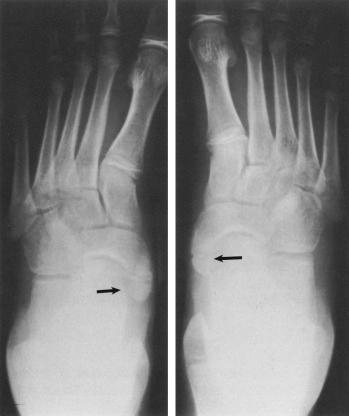
Many of these patients are asymptomatic. Symptomatic patients experience pain directly over the prominence, usually from footwear over the prominence. If the shoes are stretched or altered over this prominence, symptoms may be relieved. Other patients experience pain when the posterior tibial tendon is stretched or placed under tension. In persons with persistent pain, simple excision of the ossicle without rerouting of the tendon is usually successful.
Cavus is defined as an increase in the height of the longitudinal arch of the foot. A variety of other modifiers, such as cavovarus and calcaneocavus, are used to further describe the position of the heel. Often the patient has claw toes or hammertoes and metatarsal head calluses. The presenting complaint can be pain or abnormal wear of the shoe. A cavus foot is usually the result of muscle imbalance that is caused by an underlying neurologic disorder. The patient should undergo a meticulous neurologic examination so that evidence of disorders such as Charcot-Marie-Tooth disease, spinal dysraphism, or a spinal tumor can be detected. Nerve conduction studies may be indicated to diagnose the varieties of peripheral neuropathies. Initial radiographic evaluation should include weight-bearing views of the feet and at least an AP view of the entire spine in search of an occult spinal anomaly. An MRI of the entire spine and a neurologic consult are indicted if any question exists of an underlying neurologic disorder.
The ligaments of the ankle insert on the epiphyses distal to the physeal line ( Fig. 138.5 ). Because the physis is the weakest link in this bone-tendon-bone interface, it is usually the part that gives way when significant force is applied to the ankle. High-grade ankle sprains are unusual in the skeletally immature athlete. Physeal fractures that do occur are discussed in the next section. Minor ankle sprains occur and are diagnosed by a history of inversion or eversion strain with findings of tenderness over the anterior talofibular or deltoid ligament. Treatment consists of the usual conservative means of rest, ice, compression, elevation, and immobilization. Formal rehabilitation is rarely necessary but may be beneficial for the competitive athlete. Continued pain or disability should provoke a search for other more serious injury.
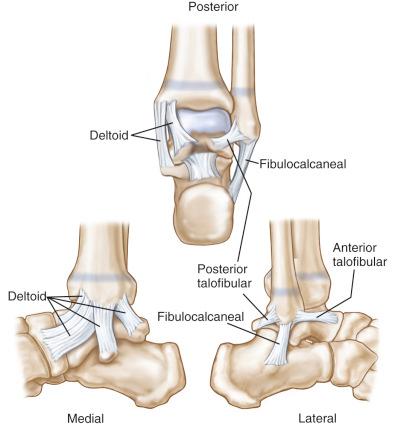
Recurrent subluxation of peroneal tendons can occur in the adolescent athlete. Usually, a history of injury is followed by recurrent episodes of a snapping sensation and pain. The subluxation can be provoked by forceful dorsiflexion with the foot everted. In patients whose symptoms are sufficiently severe, surgical correction may be indicated. Surgical alternatives include deepening the groove on the fibula, creating a bony block, and reconstructing the superior peroneal retinaculum. The first two are rarely useful in treatment of the pediatric athlete because the physis is still open. Poll and Duijfjes reviewed nine patients aged 15 to 45 years (average age, 25 years) who underwent reconstruction with the posterior calcaneofibular ligament attached to a bone block. Good results were reported.
Contusions on the foot are treated in the same way as those on any other area. Blisters are a frequent problem and require alleviation of the stress, which is usually provided by a new shoe and protection until healing occurs. Tinea pedis (athlete's foot) usually responds to a regimen of antifungal medication, along with education about the need to change socks frequently and to use antifungal powders.
There are two excellent reviews on this topic. The one by Wuerz is the most recent. Numerous systems have been proposed to classify ankle injuries. All of these classification systems take into account the position of the foot at the time of injury and the force applied. The Salter-Harris classification is based on the mechanism of injury and the pathoanatomy of the fracture pattern through the physis, as interpreted on plain radiographs and is the system most commonly used. The authors described types I through V. Type V, a crush injury, has been added to the original classification. It is difficult to recognize on plain radiographs at the time of injury; it is the result of a high-energy crush and is not discussed in this chapter ( Fig. 138.6 ).
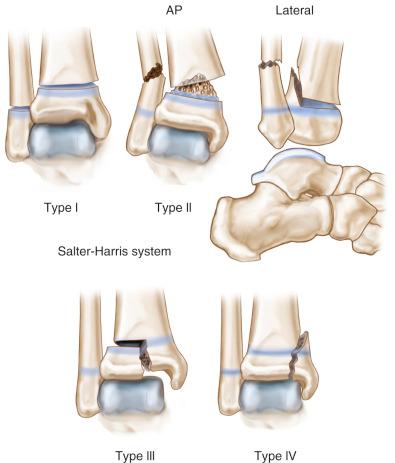
In the skeletally immature patient, the tibiotalar joint surface is rarely disturbed. The injury pattern changes in adolescence as the physis begins to close. Closure is usually complete by age 14 in females and age 16 in males. The outcome of the injury depends on the type of physeal injury and its management. Tension injuries usually produce Salter-Harris type I and II injuries of the physis. Compression forces can produce Salter-Harris type III and IV injuries. Podeszwa and Mubarak state that the incidence of accessory centers of ossification is 20% in the medial malleolus and 1% in the lateral malleolus. These must be considered when looking at unusual fracture patterns. Rohmiller and colleagues have recently used the Lauge-Hansen system to look at the mechanism of injury in Salter-Harris type II distal tibial fractures. This topic is discussed later in this chapter.
The mechanism of injury and the time elapsed since the accident should be noted. The neurovascular status of the foot should be carefully documented. The amount of swelling and the status of the skin are important. Gentle examination should be carried out to seek areas of point tenderness, especially over the physis. This examination may be more useful than radiographs in diagnosing Salter I fractures of the distal fibula. Plain radiography should include AP, lateral, and mortise views. CT and MRI are valuable techniques in assessing and classifying some fractures not clearly seen on plain radiographs, especially those that are intra-articular, because they allow more accurate evaluation of the fragments. CT is easily performed and less expensive than MRI and does not require sedation in the young child. Carey and associates performed a study of plain films and MRI in 14 patients with acute injuries. The direct visualization of cartilage afforded by MRI improved evaluation of growth plate injury in each case. MRI changed Salter-Harris classification or staging in two of nine patients for whom fractures were visualized on conventional radiographs, allowed the detection of radiographically occult fractures in 5 of 14 cases, and resulted in a physical change in management for 5 of the 14 patients studied. MRI has an important role in the evaluation of acute pediatric growth plate injury, particularly when diagnostic uncertainty persists after the evaluation of conventional radiographs. MRI allows detection of occult fractures, may alter Salter-Harris staging, and may lead to a change in patient management. CT and MRI are particularly useful in the juvenile fracture of Tillaux and in triplane fractures.
Because treatment and prognosis depend on the Salter-Harris classification, the fractures are discussed according to fracture type. Podeszwa and Mubarak recommend open reduction in all physeal fractures with a gap of 3 mm or more. They found entrapped periosteum as the main offender in causing the gap. Trapped periosteum has been implicated in an increased incidence of premature physeal closure (PPC). Removal of epiphyseal metallic implants has been recommended when used in Salter type III and IV fractures of the tibia because the contact pressures as measured in cadavers are increased by the presence of epiphyseal screws. They mention the alternative use of bioabsorbable screws to obviate the need for removal. As a general rule, any metallic fixation crossing the physis when growth potential remains should be removed to lessen the risk of physeal closure. Whenever possible, fixation should not cross the physis, and, if necessary, smooth pins should be used and then removed as soon as early healing has occurred.
Salter-Harris I fractures of the distal fibula are very common in young children and may be misdiagnosed as a sprain and go untreated. They are diagnosed by swelling and tenderness on exam and slight widening of the physis on radiographs. Immobilization in a cast or boot for 3 to 4 weeks is sufficient. In 40 years of practice, the senior author has never seen a closure of the distal fibula with a Salter I fracture. Salter-Harris I fractures of the distal tibia can be missed as well. Careful clinical exam and scrutiny of the radiographs reveal widening of the physis in the area of tenderness and swelling.
The Salter-Harris type II injury is uncommon or is frequently unrecognized in the fibula. Salter-Harris type II injury of the distal tibia combined with a fracture of the distal fibula is one of the most common injuries of the ankle, accounting for 47.3% of cases in the series compiled by Peterson and Cass.
Rohmiller and colleagues studied 91 Salter-Harris type I and II fractures of the distal tibia. No distinction was made between types I and II. Treatment options include no reduction and use of a cast, closed reduction and use of a cast, closed reduction and use of percutaneous pins and a cast, and open reduction with internal fixation. They found a 39.6% incidence of PPC. Using the Lauge-Hansen classification system, they found a significant increased incidence of PPC in pronation-abduction injuries (54%) compared with supination–external rotation injuries (35%). The most important determinant of PPC was the amount of fracture displacement after reduction. In some cases, periosteum was trapped in the fracture site medially, blocking reduction. These investigators thought that operative treatment might decrease the incidence of PPC. They recommended obtaining less than 2 mm of displacement in a child with 2 years of growth remaining to decrease the risk for PPC.
Traditional closed treatment consists of wearing a long-leg bent-knee cast for 2 to 3 weeks followed by a short-leg walking cast for 4 weeks. Dugan and coworkers reviewed 56 patients with this injury who were treated with a long-leg weight-bearing cast for 4 weeks. There were no nonunions and no angular deformities. There was one case of clinically insignificant premature closure of the growth plate. Use of a long-leg weight-bearing cast for 4 weeks appears to be the treatment of choice because it allows early healing, low morbidity, and rapid rehabilitation. A boot can be used after 4 weeks to begin ROM.
In adolescents, a Salter-Harris type III injury is also known as the juvenile fracture of Tillaux . The distal tibial physis closes first in the central region and then from the medial side toward the fibula. An external rotation force applied to the partially closed physis applies traction on the physis through the anterior inferior talofibular ligament. This process avulses a fragment of the lateral physis, which remains attached to the ligament ( Fig. 138.7 ). Closed reduction with use of an anesthetic should be attempted. The injury can be treated in a closed manner if the fragment is not displaced more than 2 mm, or if it can be reduced in a closed manner and percutaneously fixed. A smooth wire or a guidewire can be used in an attempt to satisfactorily reduce the fragment and pin it percutaneously. Most of these injuries require open reduction and fixation of the fragment with a pin or cancellous screw.
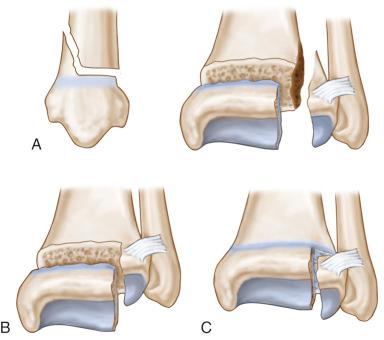
Fractures of the medial malleolus can be either type III or IV injuries. If displaced less than 2 mm, they may be treated in a closed manner, paying close attention to the medial joint space. Initially this treatment should consist of a long-leg non–weight-bearing cast for 3 weeks, followed by wearing a short-leg walking cast for 3 weeks. In open reduction cases if the Thurston-Holland fragment is large enough, it can be attached to the metaphysis to avoid crossing the physis. If it is not large enough to gain sufficient fixation, the pins should cross the physis. These injuries are the most unpredictable of ankle epiphyseal injuries. Near-anatomic reduction must be obtained.
The Salter-Harris type IV group includes some of the medial malleolar fractures and the triplane fractures. The triplane fracture, first described by Marmor, is so named because the fracture lines extend from the physis into the transverse, sagittal, and coronal planes (see Fig. 138.7 ). This type of fracture may be mistaken for a Salter-Harris type II injury if the radiographs are not carefully scrutinized.
Many authors have described this fracture and have argued about the number of fragments involved. Most of these studies were based on plain radiography. Fig. 138.7 illustrates the possibilities. In the two-part fracture, the main fragment is the tibial shaft, including the medial malleolus and a portion of the medial epiphysis. The second fragment is the remaining epiphysis, which is attached to the fibula. In the three-part injury, the third fragment is usually an anterior free epiphyseal fragment. Brown and colleagues studied 51 children with tibial triplane fractures. By evaluating them with CT with multiplanar reconstructions, these authors have used the best radiographic evaluation possible to define the number of fragments. The classic two-fragment type with medial epiphyseal extension was most frequent (occurring in 33 of 51 children). All three-fragment types (occurring in 8 of 51 children) had a separate anterolateral fragment. Extension to the medial malleolus was common (occurring in 12 of 51 children). None of the four reported fracture types involving anteromedial extension was seen.
Karrholm reviewed the literature on this injury. Triplane fracture made up 7% of physeal injuries in girls and 15% in boys. Of the injuries, 35% were treated closed without manipulation, 30% by manipulation and casting, and 35% by open reduction and internal fixation.
If this injury can be reduced to within 2 mm, it may be treated in a closed manner. In the series reported by Cooperman, 13 of 15 fractures were treated in a closed manner, and in the series reported by Dias and Giergerich five of eight were treated in this way. In the series by Ertl, residual displacement of more than 2 mm was associated with a high incidence of late symptoms. Obtaining a reduction of less than 2 mm by either closed or open means did not ensure an excellent result. Poor results may be related to damage done to the articular surface or to the amount of displacement. Fractures outside the weight-bearing area did not show this tendency toward poor results.
Evaluation of the adequacy of reduction in this injury is difficult, and because most authors recommend manipulation after induction of general anesthesia, the only radiographic means of diagnosis available is plain radiography. Our preferred method is manipulation, after the patient is sedated, by internal rotation of the foot; this manipulation is usually performed in the emergency department. If any question exists about the adequacy of reduction on plain radiographs, CT or plain tomography is used to evaluate the articular surface and the reduction ( Fig. 138.8 ). If displacement is greater than 2 mm, open reduction with internal fixation is performed, which may require two incisions. The first is an anterolateral incision, which permits identification of the anterolateral fragment. Usually, it is first necessary to reduce and fix the posterior fragment. If this procedure cannot be performed in a closed manner, a second posteromedial approach is used to reduce the fragment under direct vision. Fixation is achieved with cannulated screws, cancellous screws, or pins. These injuries require the patient to wear a cast for 6 weeks.
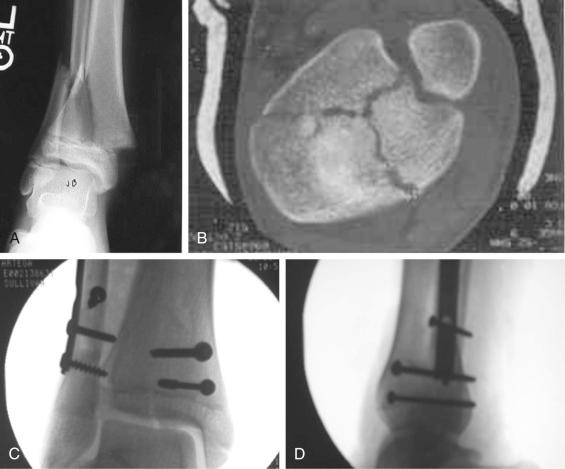
Become a Clinical Tree membership for Full access and enjoy Unlimited articles
If you are a member. Log in here